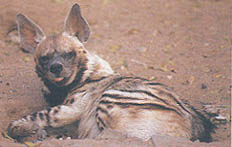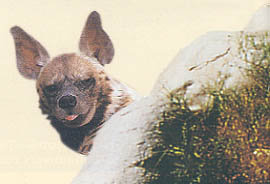The Last Laugh
© Chad Clark 8-1-01
 Just like a game of pool, the life of Hyaenida Hyaena is all about spots
and stripes. Now that their only major predator, the spotted leopard, is balanced on the
knife-edge of extinction, the striped hyena of Sinai, originally from South West Asia, is
truly the king of the desert. Or so it appeared………….
Just like a game of pool, the life of Hyaenida Hyaena is all about spots
and stripes. Now that their only major predator, the spotted leopard, is balanced on the
knife-edge of extinction, the striped hyena of Sinai, originally from South West Asia, is
truly the king of the desert. Or so it appeared………….
Born in litters of 3 or so as sweet little puppies with black
spots, they immediately start viciously fighting amongst themselves with their baby milk
teeth to gain superiority over their siblings. Although weaned by their mothers for up to
a year in a communal den where their fathers are neither wanted nor tolerated, the cubs
are introduced to the joys of meat eating after merely a few months. Growing to over a
metre in length, weighing in at 50 kg and brightly waving a bushy 30 cm tail, the boys are
kicked out of the commune at the tender age of 2 and head off into the sunset for pastures
anew. The larger fatter girls stay with their female dominated clan for the remainder of
their 25 years.
Upon maturing, their coat soon becomes a yellowy grey colour and
the black spots join up to form stripes. Their front legs are longer than their back legs,
giving them their strange but characteristic ‘something stuck between the legs’
stance. Their feet have only 4 toes which are capped by blunt, non-retractable claws. Up
on these toes, however, they can cruise around at 10 kph all day with occasional bursts of
up to 60 kph when they’re particularly hungry.
Hyena have only 34 teeth, which is less than usual for carnivores,
but their strong, conical molars are ideally suited for bone crushing, especially when
accompanied by the most powerful jaws in any mammal of comparative size. Their corrosive
digestive system is such that it can break down and absorb most of the organic matter in
bones and even
teeth within 24 hours. Since they tend to eat everyone else’s ‘left overs’
of skin and bones it’s just as well. In fact as scavengers, they’ll eat almost
anything that stays still long enough. Apart from carrion, they’ll eat small mammals,
reptiles, eggs, berries and even dead crabs washed up on the shore. Being true
opportunists, they always take the path of least resistance. Although showing great
persistence and remarkable patience, they commonly exhibit signs of cowardice when
confronted. However, there’s a point when foraging through the rubbish is no longer
sufficient and hunger overcomes ones natural reticence to make an effort. When survival
dictates, hyenas may be driven to hunt in small packs for a specific quarry. What’s
more common though, is to witness two or three hyenas squabbling and howling in their
complex language over the same putrefied carcass thus advertising their find to all the
other members for miles around. Although their sight isn’t of the best, they do
posses a keen sense of smell and acute hearing.
and even
teeth within 24 hours. Since they tend to eat everyone else’s ‘left overs’
of skin and bones it’s just as well. In fact as scavengers, they’ll eat almost
anything that stays still long enough. Apart from carrion, they’ll eat small mammals,
reptiles, eggs, berries and even dead crabs washed up on the shore. Being true
opportunists, they always take the path of least resistance. Although showing great
persistence and remarkable patience, they commonly exhibit signs of cowardice when
confronted. However, there’s a point when foraging through the rubbish is no longer
sufficient and hunger overcomes ones natural reticence to make an effort. When survival
dictates, hyenas may be driven to hunt in small packs for a specific quarry. What’s
more common though, is to witness two or three hyenas squabbling and howling in their
complex language over the same putrefied carcass thus advertising their find to all the
other members for miles around. Although their sight isn’t of the best, they do
posses a keen sense of smell and acute hearing.
Unusually in mammals, possibly even accounting for the stance, the
females wear the trousers as the superior sex, even possessing false male sexual organs.
When born, both sexes have a phallus and scrotum. When the female reaches puberty, this
phallus then splits in two revealing another orifice beneath, accompanied by an enlarging
of the teats. The female grows bigger, heavier and more dominant than her brothers, even
leading the clan on hunts and patrols. All is not lost though, for the fortunate sons of
each clans dominant female are found to command respect as pedigree studs in other clans.
Unfortunately for these chosen few, courtship and copulation is a rather bizarre process
due to the additional anatomical barriers, especially since the submissive males are also
in permanent fear of female aggression.
Sound in the knowledge that eating hyena flesh is normally taboo
as being dirty meat from a scavenger, Stripey the hyena has enjoyed several decades of
carefree unchallenged monarchy - bar the odd traffic accident. Actually, there’s also
one tribe of Gebeliya Bedouins, who for some elusive reason only forbid eating the left
side of the hyena. The right side, lightly boiled in complete contrast, is considered to
be an excellent cure for both exhaustion and rheumatism. Apart from the Gebeliya all was
well until one day, six years ago, a small spotted leopard escaped from a breeding project
in the Negev desert. Three years later some goats were horrendously attacked. The size and
severity of the bites they suffered could only have come from one animal, a maturing
spotted leopard. So, watch out Stripey, the spots are back. Who’s having the last
laugh now?
back
 Just like a game of pool, the life of Hyaenida Hyaena is all about spots
and stripes. Now that their only major predator, the spotted leopard, is balanced on the
knife-edge of extinction, the striped hyena of Sinai, originally from South West Asia, is
truly the king of the desert. Or so it appeared………….
Just like a game of pool, the life of Hyaenida Hyaena is all about spots
and stripes. Now that their only major predator, the spotted leopard, is balanced on the
knife-edge of extinction, the striped hyena of Sinai, originally from South West Asia, is
truly the king of the desert. Or so it appeared…………. and even
teeth within 24 hours. Since they tend to eat everyone else’s ‘left overs’
of skin and bones it’s just as well. In fact as scavengers, they’ll eat almost
anything that stays still long enough. Apart from carrion, they’ll eat small mammals,
reptiles, eggs, berries and even dead crabs washed up on the shore. Being true
opportunists, they always take the path of least resistance. Although showing great
persistence and remarkable patience, they commonly exhibit signs of cowardice when
confronted. However, there’s a point when foraging through the rubbish is no longer
sufficient and hunger overcomes ones natural reticence to make an effort. When survival
dictates, hyenas may be driven to hunt in small packs for a specific quarry. What’s
more common though, is to witness two or three hyenas squabbling and howling in their
complex language over the same putrefied carcass thus advertising their find to all the
other members for miles around. Although their sight isn’t of the best, they do
posses a keen sense of smell and acute hearing.
and even
teeth within 24 hours. Since they tend to eat everyone else’s ‘left overs’
of skin and bones it’s just as well. In fact as scavengers, they’ll eat almost
anything that stays still long enough. Apart from carrion, they’ll eat small mammals,
reptiles, eggs, berries and even dead crabs washed up on the shore. Being true
opportunists, they always take the path of least resistance. Although showing great
persistence and remarkable patience, they commonly exhibit signs of cowardice when
confronted. However, there’s a point when foraging through the rubbish is no longer
sufficient and hunger overcomes ones natural reticence to make an effort. When survival
dictates, hyenas may be driven to hunt in small packs for a specific quarry. What’s
more common though, is to witness two or three hyenas squabbling and howling in their
complex language over the same putrefied carcass thus advertising their find to all the
other members for miles around. Although their sight isn’t of the best, they do
posses a keen sense of smell and acute hearing.